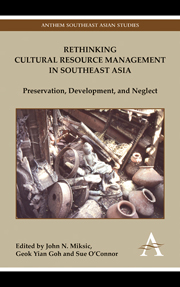Book contents
- Frontmatter
- Contents
- List of Tables and Figures
- Introduction: John N. Miksic
- Southeast Asia (General)
- East Timor
- Cambodia
- Chapter 5 Rethinking Cultural Resource Management: The Cambodian Case
- Chapter 6 Conservation of the Thnal Mrech Kiln Site, Anlong Thom, Phnom Kulen
- Chapter 7 Cultural Resource Management in Phnom Sruk: Potential and Problems
- Chapter 8 Archaeology and Cultural Resource Management South of Phnom Penh, Cambodia
- Chapter 9 Heritage Management of Wooden Prayer Halls in Battambang Province, Cambodia
- Myanmar
- The Philippines
- Singapore
- Vietnam
Chapter 6 - Conservation of the Thnal Mrech Kiln Site, Anlong Thom, Phnom Kulen
from Cambodia
Published online by Cambridge University Press: 05 May 2012
- Frontmatter
- Contents
- List of Tables and Figures
- Introduction: John N. Miksic
- Southeast Asia (General)
- East Timor
- Cambodia
- Chapter 5 Rethinking Cultural Resource Management: The Cambodian Case
- Chapter 6 Conservation of the Thnal Mrech Kiln Site, Anlong Thom, Phnom Kulen
- Chapter 7 Cultural Resource Management in Phnom Sruk: Potential and Problems
- Chapter 8 Archaeology and Cultural Resource Management South of Phnom Penh, Cambodia
- Chapter 9 Heritage Management of Wooden Prayer Halls in Battambang Province, Cambodia
- Myanmar
- The Philippines
- Singapore
- Vietnam
Summary
Background
Phnom Kulen, “the hill of the lychees” in Khmer, is a modern name given to a plateau situated north of Tonlé Sap Lake and the group of monumental complexes at Angkor, Siem Reap Province. The upper part of the plateau generally consists of thick forest and heritage sites. Phnom Kulen was also a big quarry providing shiny calcified sandstone for temple construction. This sandstone is not very hard, but it is homogenous and has a beautiful grain (Aymonier 1999, 224). According to evidence derived from a stele found at Sdok Kok Thom (in what is now eastern Thailand) dated AD 1052, Mahendraparvata, or “The Mountain of the great Indra” in Sanskrit, was the original name of this hill. The inscription states that on this plateau, King Jayavarman II was consecrated as cakravartin (“supreme overlord”) in 802 after his return from Java; the ceremony was intended to proclaim that Cambodia was now free from Java's suzerainty. Several theories have been put forward which suggest that the Kulen plateau played a decisive role in the foundation and rise of the Khmer empire of Angkor.
Eleven villages now stand on the plateau, Anlong Thom being the biggest. Most of the inhabitants belong to an aboriginal group called Samrê, but they are reluctant to admit this and have adopted Cambodian language. The enclosures of their dwellings, generally simple huts, are made with large sheets of tree bark.
- Type
- Chapter
- Information
- Rethinking Cultural Resource Management in Southeast AsiaPreservation, Development, and Neglect, pp. 101 - 116Publisher: Anthem PressPrint publication year: 2011
- 1
- Cited by



